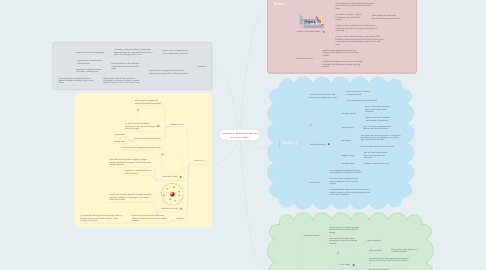
1. Section 2
1.1. atomic mass: average mass of all the isotopes of an element
1.1.1. Mendeleev noticed a pattern of properties appeared when he arranged the elements in order of increasing atomic mass
1.1.1.1. based on that he formed groups
1.2. periodic table: arrangement of elements showing repeating pattern of their properties
1.2.1. the properties can be predicted from its location on the periodic table
1.2.1.1. organized in horizontal rows called periods
1.2.1.2. organized in vertical columns, or families, called groups
1.2.2. the periodic table lists four pieces of information: an element’s atomic number, chemical symbol, name, and atomic mass
1.2.2.1. chemical symbol: representation of an element usually consisting of one or two letters
2. Section 1
2.1. Daltons Theroy
2.1.1. all elements-composed of atoms that cannot be divided
2.1.2. all aotms can't be created or destroyed in any chemical change, only rearranged
2.1.3. all atoms of the same element
2.1.3.1. Same mass
2.1.3.2. Exactly alike
2.1.4. an atom can't be changed into another atom
2.2. Thomson's model
2.2.1. found that atoms contain negativly charged particles scattered throughout a ball of posativly charged particles
2.2.2. Negativly charged partices are called electrons
2.3. Rutherford's Model
2.3.1. Found that an atoms posativly charged particles must be clustered in a tiny region in its center called the nucleus
2.4. Isotopes
2.4.1. atoms of the same element that have different numbers of neutrons are called isotopes
2.4.1.1. They are identified by its mass number, which is the sum of the protons and neutrons in the nucleus of an atom
3. Section 3
3.1. Metals are elements that are good conductors of electric current and heat
3.1.1. luster, malleability, ductility, and conductivity
3.1.1.1. malleable material: can be hammered or rolled into flat sheets or other shapes
3.1.1.2. ductile material: one that can be pulled out, or drawn, into a long wire.
3.2. Conductivity
3.2.1. Thermal conductivity: the ability of an object to transfer heat
3.2.2. Electrical conductivity: the ability to transfer electric current
3.3. Chemical properties
3.3.1. reactivity: the ease and speed with which a substance reacts with other substances
3.3.2. Corrosion: The gradual wearing away of a metal due to a chemical reaction
3.4. Metals in the periodic table
3.4.1. The reactivity of metals tends to decrease as you move left to right across the periodic table
3.4.2. The metals in group 1, lithium to francium, are called alkali metals
3.4.2.1. alkali metals react with other elements by losing one electron
3.4.3. Group 2 contains alkaline earth metals each is fairly hard, grey-white, and a good conductor of electricity
3.4.4. Group 3-12 are called transition metals most of the transition metals are shiny and hard, they are also good conductors, some include gold, copper, nickel, and silver
3.5. synthetic elements
3.5.1. scientists make synthetic elements by forcing nuclear particles to crash into one another
3.5.2. Particle accelerators move atomic nuclei faster and faster until they have reached very high speeds
4. Section 4
4.1. A nonmetal is an element that lacks most properties of a metal
4.1.1. poor conductors of electric current and heat.
4.1.2. Solid nonmetals are dull and brittle
4.2. nonmetal families
4.2.1. Nitrogen Family
4.2.1.1. gain or share three electrons when reacting with other elements
4.2.1.2. diatomic molecule: molecule that consists of two atoms
4.2.2. Carbon family
4.2.2.1. gain or lose four electrons when reacting with other elements
4.2.3. Inert gasas
4.2.3.1. Inert gases do not ordinarily form compounds because atoms of inert gases do not usually gain lose or share electrons
4.2.3.2. The inert gases tend to be un-reactive
4.2.4. Oxygen family
4.2.4.1. gain or share two electrons when reacting with other elements
4.2.5. Halogen family
4.2.5.1. halogen means salt forming
4.3. Semi-metals
4.3.1. some properties of metals but also have properties of typical nonmetals
4.3.2. The most useful property is there very an ability to conduct electric current
4.3.3. Semiconductors: substances that can conduct electric current under some conditions but not under other conditions
5. Section 5
5.1. Radioactive decay
5.1.1. atomic nuclei of unstable isotopes release fast moving particles and energy
5.1.2. discovered by accident while studying a mineral tat contained uranium
5.1.2.1. Henri Bacquerel
5.2. Types of radioactive decay
5.2.1. Alpha decay
5.2.1.1. Alpha particles
5.2.1.1.1. two protons, two neutrons, is posativly charged
5.2.1.2. the release of the alpha particle decreases the atomic number by 2 and the atomic mass by 4
5.2.1.3. gets blocked by paper
5.2.2. Beta decay
5.2.2.1. beta particles
5.2.2.1.1. a fast moving electron that is given off by a nucleus
5.2.2.2. a neutron inside unstable nucleus changes into a negativly charged beta particle and a protons
5.2.2.3. Stopped by aluminum sheet
5.2.3. Gamma decay
5.2.3.1. Gamma radiation
5.2.3.1.1. consists of high-energy waves, similar to X-rays
5.2.3.2. no charge, does not change atomic mass or atomic number
5.2.3.3. mostly stopped by concrete
